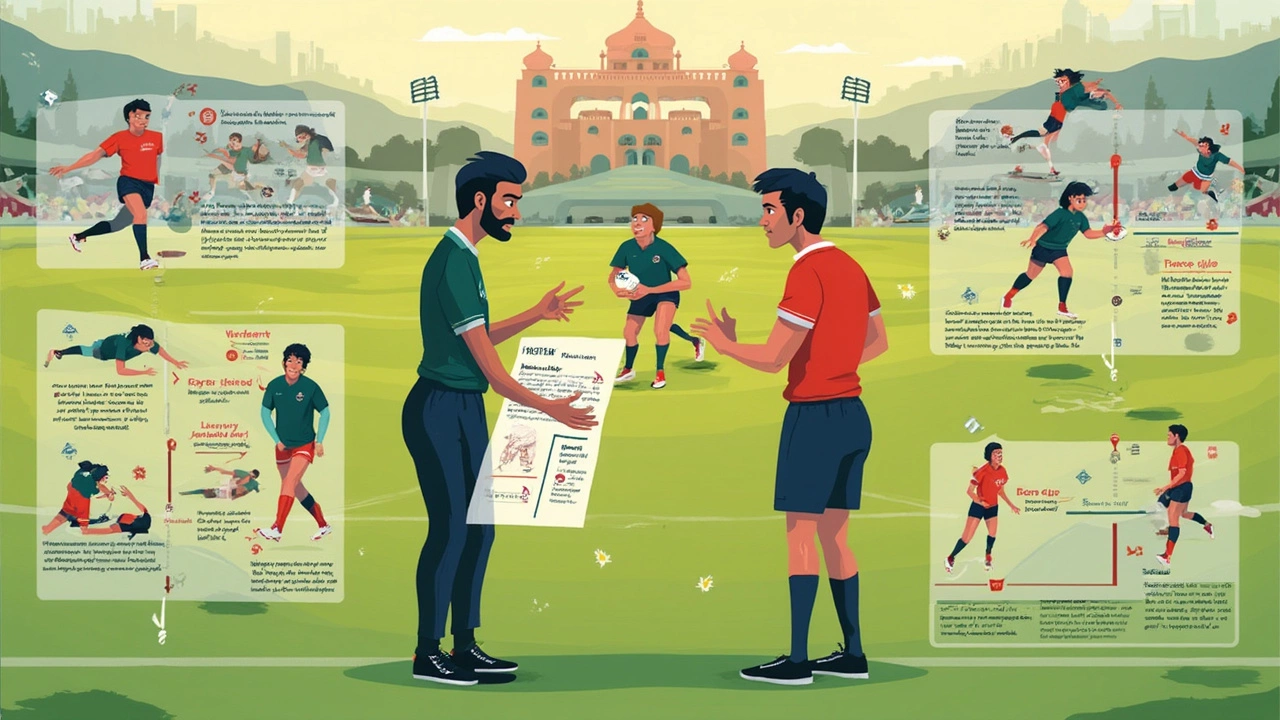Ever wondered why rugby fans cheer so hard when someone scores what looks like a touchdown? Well, that's because, in rugby lingo, it's actually called a 'try.' It's the bread and butter of rugby scoring, and if you're new to the game, understanding this term is key.
A 'try' in rugby isn't just about crossing a line—it's about grounding the ball in the opposing team's in-goal area. Score one, and you rack up five nifty points for your team, plus a chance for extra conversion points. It's like getting the main course with a side dish!
Interestingly, the whole concept of a try is very different from a football touchdown. Want more tips and insights on this fascinating sport? Keep reading as we tackle more on rugby's unique scoring style and legends behind it.
Rugby Scoring Basics
Alright, let's get to the heart of how points are racked up in rugby. If you're a fan of rugby, you need to get comfortable with its scoring system, which can seem like a maze at first but is pretty straightforward once you break it down.
The big star here is what we've already mentioned—the 'try.' Score a try, and you're giving your team a sweet five-point boost. But it's not just about running across the line with the ball. You must ground the ball in the opposing team’s in-goal area. It sounds deceptively simple, but those defending players aren't going to let it slide easily.
Once a try is scored, the excitement isn't over. Up next is the conversion kick. If nailed, it adds two extra points to the scoreboard. The kicker gets to attempt this from a spot aligned with where the try was scored, making it a strategic decision.
Points Breakdown
- A try is worth five points. It's the primary target for any team.
- A conversion kick, post-try, can bag you two more points. Aim well!
- Drop goals and penalties also play their part—both worth three points each.
Understanding Other Ways to Score
Besides tries, there are other nifty ways to score. A penalty kick lets you go for three points when the other team fouls. And don’t underestimate a drop goal—it’s the same point value as a penalty and depends on incredible timing.
| Scoring Method | Points |
|---|---|
| Try | 5 |
| Conversion | 2 |
| Penalty | 3 |
| Drop Goal | 3 |
Having a grip on these scoring methods not only boosts your understanding but makes watching rugby fixtures a whole lot more fun. Get out there and root for those tries!
The Art of the Try
So, what's the big deal about a rugby try? Simply put, it’s the ultimate goal on the field that players strive for. Unlike in American football, where a touchdown can be scored by merely carrying or catching the ball in the end zone, rugby requires a bit more finesse. You gotta ground the ball properly in the in-goal area. If that ball doesn't touch the turf, it doesn't count!
A perfect mix of strategy, skill, and teamwork goes into scoring a try. Players must dance around fierce tackles, find gaps in defenses and make those split-second decisions to either pass or go for it. Sounds intense, right? That’s because it is!
Tactics Behind a Try
Scoring a rugby try isn't just about power; brains come into play too. Teams often use sneaky set plays that are practiced to the bone. Here are some of the usual tactics:
- Offloading: As players get tackled, they pass the ball to a teammate to keep moving forward.
- Dummy Pass: Faking a pass to trick opponents and open up space.
- Side-stepping: Deceptive footwork to dodge opponents and break tackles.
If you think rugby players are just brutes, think again. These guys are tactical ninjas on the field, making calculated moves to break the defense and score that precious try.
Historic Tries
There have been some legendary tries over the years that have left fans gasping. Jonah Lomu's bulldozing effort in the 1995 Rugby World Cup is a classic. He ran through England's defense like a tank, showcasing power and precision.
Then there’s the famous 2003 World Cup final, where Australia and England were neck-and-neck until England's Jonny Wilkinson netted that match-winning drop goal. All thanks to a setup from earlier tries that kept them in the game!
As you can see, a try is not just a moment of brilliance; it is an art form crafted with strategy and flair, making rugby such an exhilarating sport to watch.

Comparing Rugby and American Football
When folks start comparing rugby and American football, it's easy to see why there's some confusion. Sure, both games involve running a ball and trying to score, but that's where the similarities mostly end.
Scoring Differences
First up, let's talk scoring. In rugby, a word you'll need to know is a try, which, as we already mentioned, nets you five points. Interestingly, a touchdown in American football is worth six points. Both sports offer extra opportunities for additional points afterward, known as conversions and extra points, respectively.
Game Duration and Structure
Here's a bit of trivia: rugby matches are often quicker affairs at two 40-minute halves, while American football games, thanks to all those breaks and plays, can stretch on for three hours or more. Rugby's fast pace often keeps spectators on the edge of their seats.
Player Roles and Equipment
Another point to note: rugby players are often in play constantly, with no specialized offensive or defensive units like in football. That means everyone has to pitch in on both sides. Plus, rugby's lack of significant padding might surprise you if you're used to the layers of gear seen in American football. It's all about tackling with technique over brute force.
Field Sizes
Curious about field size? Rugby pitches are generally larger, about 100 meters long, compared to American football fields at 91.44 meters. This extra space gives rugby its signature open gameplay, encouraging strategic runs and passes across the pitch.
Popularity and Global Reach
While American football reigns supreme in the U.S., rugby enjoys a solid fanbase around the globe, especially in countries like New Zealand, South Africa, and the UK. It's a game that's truly international, connecting fans with its unique mix of skill, strategy, and athleticism.
So, whether you're a fan of the helmets and tackles or the scrums and tries, both sports offer a unique view into the world of intense, exciting athletic competitions. The choice ultimately boils down to what style of play you enjoy watching or playing the most!
Fun Facts About Rugby
Rugby is not just about intense scrums and tactical plays. It's packed with quirky facts and a rich history that even die-hard fans find fascinating.
The Birth of Rugby
The origins of rugby are often attributed to a spontaneous act at Rugby School in England in 1823. Legend has it that William Webb Ellis picked up a soccer ball and ran with it, breaking the norms and creating what we now know as rugby.
Two Types, One Game
Did you know there are two main types of rugby? Rugby Union and Rugby League. They might look similar at first glance but have key differences, like the number of players. Rugby Union has 15 players on each side, while Rugby League fields 13.
A Sport for All Shapes and Sizes
Rugby is unique because it truly welcomes players of all body types. There's a position for everyone, whether you're tall and lanky or short and sturdy.
Global Reach
Rugby is played in over 120 countries, from New Zealand to Namibia. It's no wonder it has its own World Cup, held every four years. The 2019 Rugby World Cup in Japan broke records with more than 850 million viewers from around the globe.
Rugby in Numbers
Think you know how fast things move in rugby? Check out these stats:
| Fact | Stat |
|---|---|
| Average player sprint speed | 20 mph |
| Average tackles per game | 200 |
| Top conversion kick distance | 68 meters |
These fun facts give us a peek into why rugby isn't just a game—it's a culture. From its unexpected inception to its global stage, rugby's journey is as gripping as the game itself.
